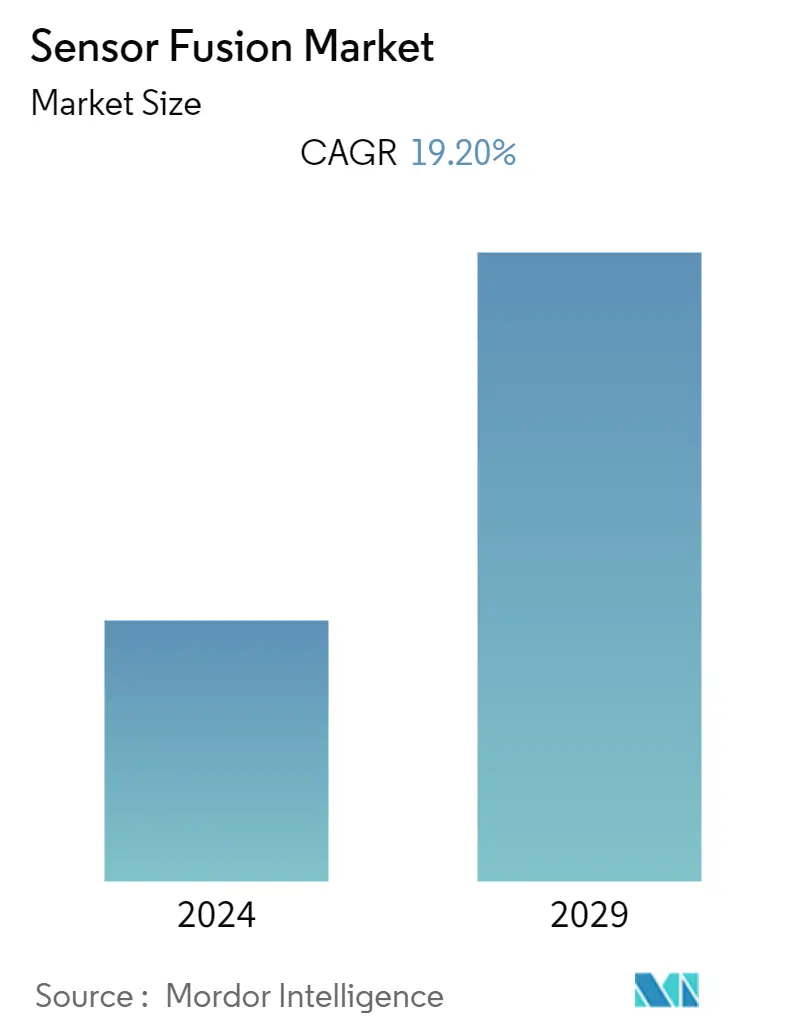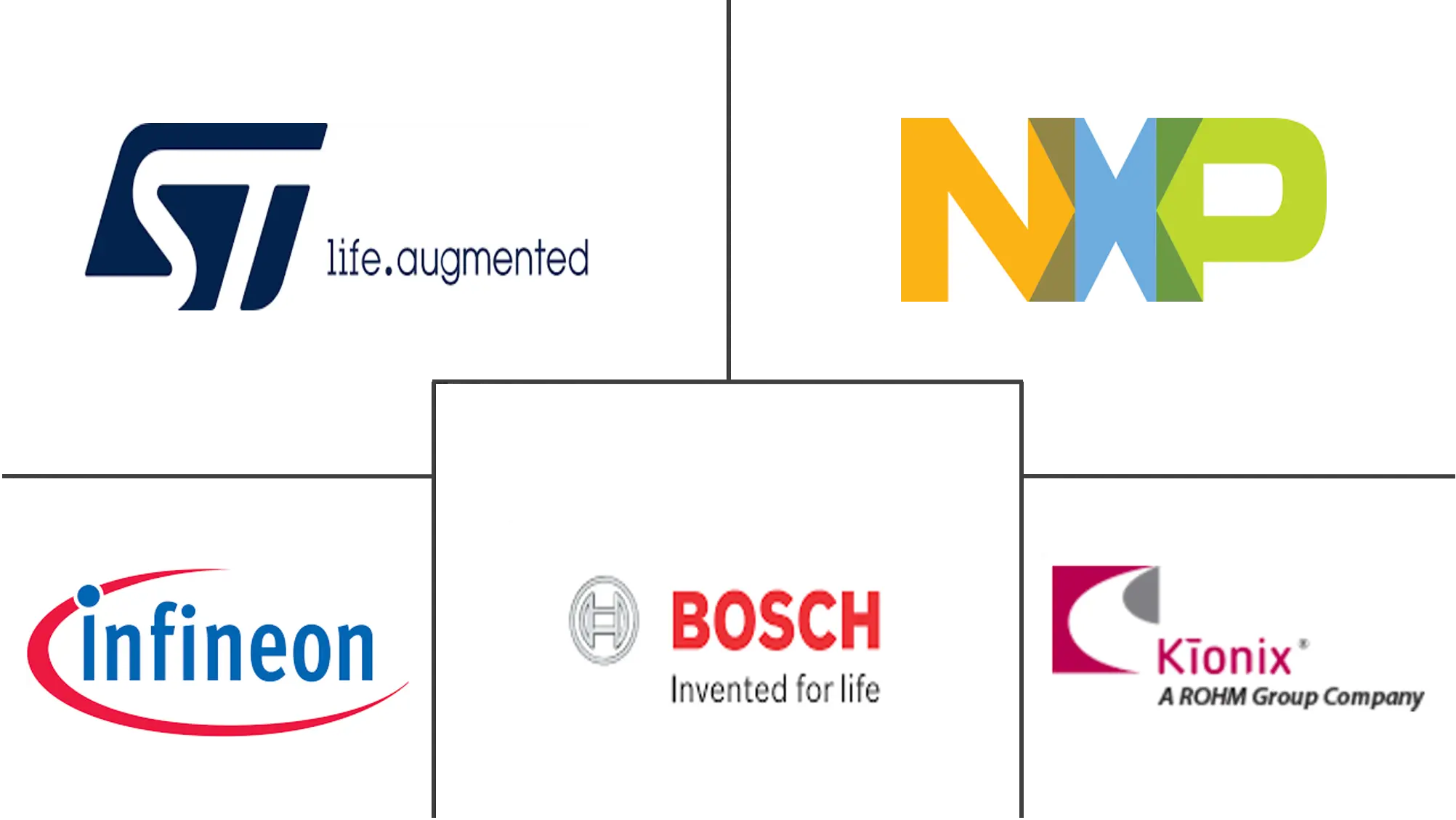Market Size of Sensor Fusion Industry

| Study Period | 2019 - 2029 |
| Base Year For Estimation | 2023 |
| CAGR | 19.20 % |
| Fastest Growing Market | Asia Pacific |
| Largest Market | North America |
| Market Concentration | Low |
Major Players
*Disclaimer: Major Players sorted in no particular order |
Sensor Fusion Market Analysis
The Sensor Fusion Market is expected to grow by registering a CAGR of 19.2% during the forecast period. The growing trend of autonomous vehicle and advanced driver assistance systems (ADAS) are further integrating new radar, camera, lidar, and GNSS sensors into these vehicles. This rapid change requires flexible test systems to deploy products quickly and safely, driving the industry's need for sensor fusion systems. Therefore, the growing functionality of autonomous vehicles is mainly driving the growth of the sensor fusion market over the forecast period.
- Resolving contradictions between sensors, synchronizing sensors, predicting the future positions of objects, and achieving automated driving safety requirements are some of the primary objectives of sensor fusion in an autonomous vehicle application. The growing integration of autonomous features in automobiles is expected to drive the growth of the studied market during the forecast period.
- According to the World Economic Forum (WEF), more than 12 million fully autonomous cars are expected to be sold annually by 2035, and autonomous vehicles will account for 25% of the global automotive market. Furthermore, according to Intel, a single autonomous vehicle can generate an average of 4 terabytes of data per day. Hence, sensor fusion solutions can play a significant role in utilizing this massive data in real time.
- Stringent government regulations across the globe are also fuelling the demand for the studied market products. For instance, in Europe, Euro NCAP (European New Car Assessment Program) mandates the deployment of at least one driver assistance system. Countries like Japan and the United States are also adopting similar criteria in their national NCAP rules.
- Furthermore, The rising adoption of 5G technology is further expanding the scope of sensor fusion towards heavy commercial vehicles and autonomous vehicles like drones and industrial robots. 5G will massively bring Vehicle-to-everything (V2X) technology to the automotive and transportation industry, increasing the demand for sensor fusion due to growth in the markets Mobility-as-a-Service (MaaS), smart bus, and robot taxis, among others.
- Many automotive manufacturers are also initiating sensor fusion development programs, mainly to leverage competitive advantage. For instance, in May 2022, LeddarTech, a provider of flexible, robust, and accurate ADAS and AD sensing technology, opened LeddarTech's Sensor Fusion and Perception Development Center in Tel Aviv.
- However, standardization is one of the major factors hindering the evolution of sensor fusion systems, as the absence of any specific global standard significantly hinders the further evolution and mass adoption of this technology.
- The recent recession in the global automotive sector owing to the COVID-19 outbreak has not only affected the demand in the studied market but can have a mid-term impact on the adoption rate considering the after-effects of the pandemic. However, in the long term, the growth of electric and autonomous vehicles will support the studied market's growth.
Sensor Fusion Industry Segmentation
Sensor fusion refers to the process of merging data from multiple sensors to reduce the uncertainty involved in a robot's navigation motion or task performance. These sensors include cameras, radar, LiDAR, Time-of-Flight (ToF), microphones, and inertial measurement units (IMU).The three fundamental ways of combining sensor data are Redundant sensors, Complementary sensors, and Coordinated sensors.
The market has been segmented based on the Type of Vehicle and Geography. Passenger, Light Commercial, and Heavy Commercial vehicles have been included in the study. In other Autonomous Vehicles segments, drones and autonomous robots are considered while evaluating the scope of the segment. The study also assesses the impact of COVID-19 on the market. The market sizes and forecasts are provided in terms of value (USD million) for all the above segments.
| By Type of Vehicles | |
| Passenger Cars | |
| Light Commercial Vehicle (LCV) | |
| Heavy Commercial Vehicle (HCV) | |
| Other Autonomous Vehicles |
| By Geography | |
| North America | |
| Europe | |
| Asia Pacific | |
| Latin America | |
| Middle-East and Africa |
Sensor Fusion Market Size Summary
The sensor fusion market is poised for significant growth, driven primarily by the increasing integration of autonomous features in vehicles and the rising demand for advanced driver assistance systems (ADAS). The market is experiencing a surge in the adoption of radar, camera, lidar, and GNSS sensors, which are essential for enhancing the functionality and safety of autonomous vehicles. This trend is further supported by stringent government regulations mandating the deployment of driver assistance systems, particularly in regions like Europe, Japan, and the United States. The emergence of 5G technology is also expanding the scope of sensor fusion applications, facilitating advancements in Vehicle-to-Everything (V2X) technology and enhancing the capabilities of autonomous and heavy commercial vehicles. Despite challenges such as the lack of global standardization, the market is witnessing robust development, with automotive manufacturers actively investing in sensor fusion technologies to gain a competitive edge.
The Asia Pacific region is a key player in the sensor fusion market, driven by the rapid adoption of autonomous vehicles and significant investments in 5G infrastructure. Countries like China are at the forefront, leading in the development and adoption of electric and autonomous vehicles. The region's strong semiconductor industry and supportive government policies are further propelling market growth. The sensor fusion market is characterized by intense competition, with numerous players striving to innovate and capture market share. Companies such as Robert Bosch GmbH, Infineon Technologies AG, NXP Semiconductor, and STMicroelectronics NV are actively expanding their presence through technological advancements and strategic partnerships. Recent developments, such as ZF's Smart Camera 6 and STMicro's 6-axis IMU with embedded AI, highlight the ongoing innovation in sensor fusion technologies, which are crucial for the future of automated driving and safety systems.
Sensor Fusion Market Size - Table of Contents
-
1. MARKET INSIGHTS
-
1.1 Market Overview
-
1.2 Industry Attractiveness - Porter's Five Force Analysis
-
1.2.1 Bargaining Power of Suppliers
-
1.2.2 Bargaining Power of Buyers/Consumers
-
1.2.3 Threat of New Entrants
-
1.2.4 Threat of Substitute Products
-
1.2.5 Intensity of Competitive Rivalry
-
-
1.3 Industry Value Chain Analysis
-
1.4 Technology Snapshot
-
1.5 Impact of COVID-19 on the Market
-
-
2. MARKET SEGMENTATION
-
2.1 By Type of Vehicles
-
2.1.1 Passenger Cars
-
2.1.2 Light Commercial Vehicle (LCV)
-
2.1.3 Heavy Commercial Vehicle (HCV)
-
2.1.4 Other Autonomous Vehicles
-
-
2.2 By Geography
-
2.2.1 North America
-
2.2.2 Europe
-
2.2.3 Asia Pacific
-
2.2.4 Latin America
-
2.2.5 Middle-East and Africa
-
-
Sensor Fusion Market Size FAQs
What is the current Sensor Fusion Market size?
The Sensor Fusion Market is projected to register a CAGR of 19.20% during the forecast period (2024-2029)
Who are the key players in Sensor Fusion Market?
Robert Bosch GmbH, Infineon Technologies AG, NXP Semiconductor, STMicroelectronics NV and Kionix Inc (Rohm Semiconductor) are the major companies operating in the Sensor Fusion Market.

